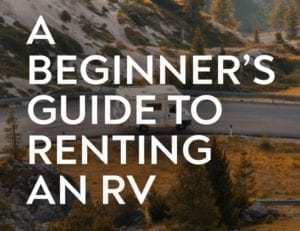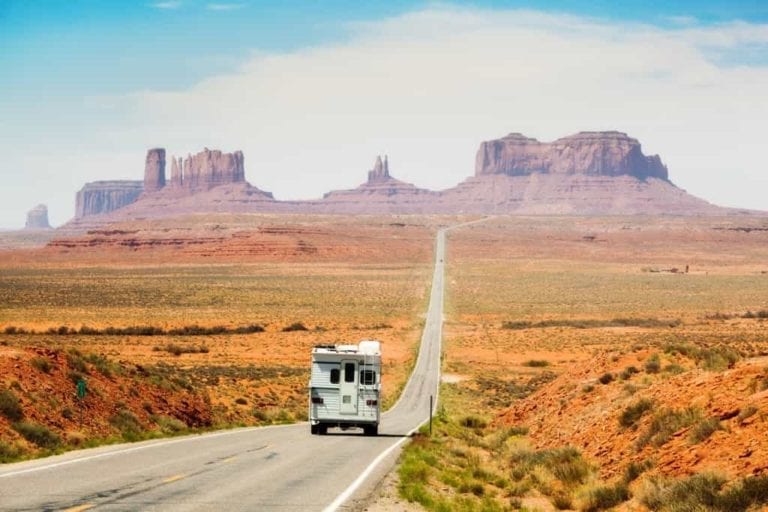A BEGINNER'S GUIDE TO RENTING AN RV

By Terry Ward
June 3rd, 2020
From choosing the right model, to tips for backing into your campsite.
The possibility of renting an RV this summer trip was never in Teena Garbus’s plans. But the mother of two from Tampa, Florida, says that, after the coronavirus pandemic caused her to cancel roughly nine trips this year—including three cruises, jaunts to Disney World, Las Vegas, and New York City for Mother’s Day—the idea of an RV vacation with her family is looking better than ever.
“Having our own private space where we can can control what comes in and out [as] we do at home is the driving force,” says Garbus, who hopes to drive to Chattanooga, Tennessee, for a week’s vacation with her gang. On the itinerary? “Hitting a bunch of parks along the way.”
Hardly alone, Garbus is one in a tidal wave of travelers destined to try out RV vacationing for the first time this summer. According to peer-to-peer rental operator RVshare, bookings have more than doubled from this time last year, signifying a renewed confidence by travelers to hit the road. Cruise America—North America’s largest RV rental operator, with more than 120 outposts across the U.S. and Canada—also reports that domestic business is soaring, with first-time RV renters in particular causing phones to ring off the hook. And they have a lot of questions.
“Our normal call [to the reservations line] averages about five minutes,” says Michael Smalley, Cruise America’s executive vice president. “Now we’re up to 10 or 12 minutes a call. It’s indicative of first-timers, they just need a little more hand holding.”
To be sure, knowing how to rent an RV takes a tad more research than a rental car—but it’s less intimidating than most people think. To get you started, read on for everything a first-timer should know when considering an RV rental, and you’ll be hitting the road in no time.
What type of RV to start with
The first thing to learn are your ABCs. All RVs are divided into A, B, and C classifications, which relate to the size and make of the RV. Settling on one will be your single biggest decision in renting an RV.
Limit yourself to B and C classes if you’re a first-time renter, since they’re smaller and easier to maneuver than the bus-like Class A, says Jason Epperson of the popular podcast and website RV Miles.
Between 16 and 22 feet long, Class B motorhomes are basically camper vans, ideal for two people traveling together, Epperson says. Class C motorhomes, usually between 21 and 35 feet long, have an overhead cab area that provides extra space for sleeping, in addition to the larger interior space—ideal for families of four or more. Up to 45 feet long, Class A RVs are far larger—think rockstar tour buses—and often come with upgraded finishes in the kitchen and bathroom.
While you don’t need a special license to drive Class A, Class B, nor most Class C RVs, there’s a huge difference in how they drive. Class B motorhomes drive like a van or truck, which is easy for first timers. Driving a Class C RV is like driving a moving truck—you lose the rearview mirror function, since you’re looking into the back of the motorhome. Class A motorhomes drive like the big buses they are.
After deciding on the right RV class, choosing the specific model to rent will depend on the RVs available near you. (Go RVing‘s survey will help you sift through various styles.) As you compare options, be clear about what features each comes with, advises Epperson. There are some standards you can count on across the board, including campsite hookup tools like sewer hoses and electric cables, small kitchens (with a two-burner stove, microwave, and small fridge), and bathrooms with a toilet, small sink, and shower drain on the floor. But some rentals will also come with kitchen accessories, like pots and pans; others may come with outdoor chairs. Some include none of the above. “You want to know what they’re giving you, so you know what [else] to bring along,” says Epperson.
Where to book
There are many RV rental companies to choose from, but two are standouts for first-time renters: the aforementioned Cruise America and RVShare. Broadly speaking, you can think of Cruise America like a chain hotel, where you can expect a standardized experience and offerings, and RVshare like the Airbnb of motorhome rentals—decor, rates, and rules vary, since they’re all individually owned.

TK Pickup camper recreational vehicle touring the American Southwest on a highway road trip near Monument Valley Tribal Park. Along the Utah and Arizona border, USA. The sandstone plateaus and rock formations are a campus place and travel destination for family vacations.
Cruise America rents Class C RVs in varying sizes, all of which have the overhead cab feature, but don’t expect bells and whistles. The company strips things to the basics—vinyl interiors and hardwood floors designed for “vigorous vacation use,” says Smalley—to keep prices down. The company’s website also has educational videos you can watch beforehand for a smoother (largely contactless) pick-up. Cruise America’s rental fee includes insurance and third-party liability, but know that there’s an added cost for miles driven (you’ll be charged between 17 and 35 cents a mile, for every mile you drive between pick-up and drop-off).
As a peer-to-peer rental company, RVshare takes a different approach, allowing customers to rent RVs directly from owners. The company offers 24-hour roadside assistance and insurance with all rentals. Some owners include unlimited mileage in their rates, while others stipulate mileage limits and overage rates, so be sure to read listings carefully.
Mapping out your journey
On short trips of a week or two, planning in advance is essential for making the most of your time—and that starts with deciding exactly where you plan to park along your route.
If you want to park at a U.S. national park, you won’t be the only one. Plan to book your campsite up to a year in advance—but keep in mind that last minute cancellations, and thus last minute availability, aren’t uncommon either. State parks are a great option as well, as they’re often less crowded and just as beautiful, says Ilona Duncan, author of At Home on the Road, who spent years traveling across the U.S. and Canada by RV. Her state park picks? Matanuska Glacier State Recreation Area, near Anchorage, and Lake Texoma State Park, in Oklahoma, near the Texas border.
A few sites also make it easy to find RV-friendly campgrounds in several regions. Kampgrounds of America, Inc. (better known as KOA), has more than 500 privately-owned campgrounds in the U.S. and Canada. Campendium is useful tool for sorting campgrounds throughout the country by location, price, variety of hookups, and even cell reception (the latter is for members only), with loads of reviews from other users. Wherever you’re headed, Toby O’Rourke, KOA’s president and CEO, suggests new campers select pull-through sites to avoid having to back in.
Citation:
Ward, Terry. “A Beginner’s Guide to Renting an RV.” Condé Nast Traveler, Condé Nast Traveler, 3 June 2020, www.cntraveler.com/story/how-to-rent-an-rv-a-first-timers-guide.
Getty Images
